Ingmar Bergman
Ernst Ingmar Bergman[lower-alpha 1] (14 July 1918 – 30 July 2007) was a Swedish director, writer, and producer who worked in film, television, theatre and radio. Considered to be among the most accomplished and influential filmmakers of all time,[1][2][3] Bergman's films include The Seventh Seal (1957), Wild Strawberries (1957), Persona (1966), Cries and Whispers (1972), Scenes from a Marriage (1973), Autumn Sonata (1978) and Fanny and Alexander (1982); the last two exist in extended television versions.
Ingmar Bergman | |
|---|---|
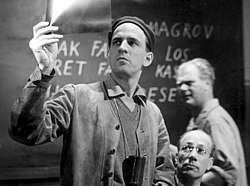 Bergman during production of Wild Strawberries (1957) | |
| Born | Ernst Ingmar Bergman 14 July 1918 Uppsala, Sweden |
| Died | 30 July 2007 (aged 89) Fårö, Sweden |
| Other names | Buntel Eriksson |
| Occupation |
|
| Years active | 1944–2005 |
| Spouse(s) |
|
| Children | 9; including:
|
| Awards |
|
| Signature | |
 | |
Bergman directed over sixty films and documentaries for cinematic release and for television screenings, most of which he also wrote. He also directed over 170 plays. He eventually forged a creative partnership with his cinematographers Gunnar Fischer and Sven Nykvist. Among his company of actors were Harriet and Bibi Andersson, Liv Ullmann, Gunnar Björnstrand, Erland Josephson, Ingrid Thulin and Max von Sydow. Most of his films were set in Sweden, and many films from Through a Glass Darkly (1961) onward were filmed on the island of Fårö.
Philip French referred to Bergman as "one of the greatest artists of the 20th century ... he found in literature and the performing arts a way of both recreating and questioning the human condition."[4] Director Martin Scorsese commented; "If you were alive in the 50s and the 60s and of a certain age, a teenager on your way to becoming an adult, and you wanted to make movies, I don't see how you couldn't be influenced by Bergman ....It's impossible to overestimate the effect that those films had on people."[5]
Biography
Early life
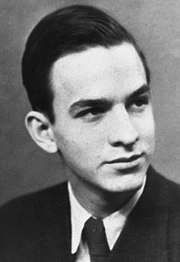
Ernst Ingmar Bergman was born on 14 July 1918 in Uppsala, Sweden,[6] the son of Erik Bergman, a Lutheran minister and later chaplain to the King of Sweden, and Karin (née Åkerblom), a nurse who also had Walloon[7] ancestors.[8] He grew up with his older brother Dag and sister Margareta surrounded by religious imagery and discussion. His father was a conservative parish minister with strict ideas of parenting. Ingmar was locked up in dark closets for infractions such as wetting himself. "While father preached away in the pulpit and the congregation prayed, sang, or listened", Ingmar wrote in his autobiography Laterna Magica,
I devoted my interest to the church's mysterious world of low arches, thick walls, the smell of eternity, the coloured sunlight quivering above the strangest vegetation of medieval paintings and carved figures on ceilings and walls. There was everything that one's imagination could desire—angels, saints, dragons, prophets, devils, humans ...
Although raised in a devout Lutheran household, Bergman later stated that he lost his faith when aged eight, and only came to terms with this fact while making Winter Light in 1962.[9] His interest in theatre and film began early: "At the age of nine, he traded a set of tin soldiers for a magic lantern, a possession that altered the course of his life. Within a year, he had created, by playing with this toy, a private world in which he felt completely at home, he recalled. He fashioned his own scenery, marionettes, and lighting effects and gave puppet productions of Strindberg plays in which he spoke all the parts."[10][11]
Bergman attended Palmgren's School as a teenager. His school years were unhappy,[12] and he remembered them unfavourably in later years. In a 1944 letter concerning the film Torment (sometimes known as Frenzy), which sparked debate on the condition of Swedish high schools (and which Bergman had written),[13] the school's principal Henning Håkanson wrote, among other things, that Bergman had been a "problem child".[14] Bergman wrote in a response that he had strongly disliked the emphasis on homework and testing in his formal schooling.
In 1934, aged 16, he was sent to Germany to spend the summer holidays with family friends. He attended a Nazi rally in Weimar at which he saw Adolf Hitler.[15] He later wrote in Laterna Magica (The Magic Lantern) about the visit to Germany, describing how the German family had put a portrait of Hitler on the wall by his bed, and that "for many years, I was on Hitler's side, delighted by his success and saddened by his defeats".[16] Bergman commented that "Hitler was unbelievably charismatic. He electrified the crowd. ... The Nazism I had seen seemed fun and youthful".[17] Bergman did two five-month stretches in Sweden of mandatory military service.[18]
Bergman enrolled at Stockholm University College (later renamed Stockholm University) in 1937, to study art and literature. He spent most of his time involved in student theatre and became a "genuine movie addict".[19] At the same time, a romantic involvement led to a physical confrontation with his father which resulted in a break in their relationship which lasted for many years. Although he did not graduate from the university, he wrote a number of plays and an opera, and became an assistant director at a local theatre. In 1942, he was given the opportunity to direct one of his own scripts, Caspar's Death. The play was seen by members of Svensk Filmindustri, which then offered Bergman a position working on scripts. He married Else Fisher in 1943.
Film career until 1975
Bergman's film career began in 1941 with his work rewriting scripts, but his first major accomplishment was in 1944 when he wrote the screenplay for Torment (a.k.a. Frenzy) (Hets), a film directed by Alf Sjöberg. Along with writing the screenplay, he was also appointed assistant director of the film. In his second autobiographical book, Images: My Life in Film, Bergman describes the filming of the exteriors as his actual film directorial debut.[20] The film sparked debate on Swedish formal education. When Henning Håkanson (the principal of the high school Bergman had attended) wrote a letter following the film's release, Bergman, according to scholar Frank Gado, disparaged in a response what he viewed as Håkanson's implication that students "who did not fit some arbitrary prescription of worthiness deserved the system's cruel neglect".[13] Bergman also stated in the letter that he "hated school as a principle, as a system and as an institution. And as such I have definitely not wanted to criticize my own school, but all schools."[21][22] The international success of this film led to Bergman's first opportunity to direct a year later. During the next ten years he wrote and directed more than a dozen films, including Prison (Fängelse) in 1949, as well as Sawdust and Tinsel (Gycklarnas afton) and Summer with Monika (Sommaren med Monika), both released in 1953.
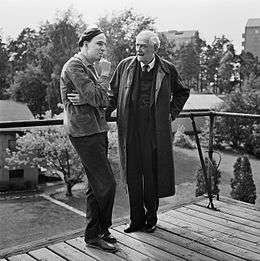
Bergman first achieved worldwide success with Smiles of a Summer Night (Sommarnattens leende, 1955), which won for "Best poetic humour" and was nominated for the Palme d'Or at Cannes the following year. This was followed by The Seventh Seal (Det sjunde inseglet) and Wild Strawberries (Smultronstället), released in Sweden ten months apart in 1957. The Seventh Seal won a special jury prize and was nominated for the Palme d'Or at Cannes, and Wild Strawberries won numerous awards for Bergman and its star, Victor Sjöström. Bergman continued to be productive for the next two decades. From the early 1960s, he spent much of his life on the island of Fårö, where he made several films.
In the early 1960s he directed three films that explored the theme of faith and doubt in God, Through a Glass Darkly (Såsom i en Spegel, 1961), Winter Light (Nattvardsgästerna, 1962), and The Silence (Tystnaden, 1963). Critics created the notion that the common themes in these three films made them a trilogy or cinematic triptych. Bergman initially responded that he did not plan these three films as a trilogy and that he could not see any common motifs in them, but he later seemed to adopt the notion, with some equivocation.[23][24] His parody of the films of Federico Fellini, All These Women (För att inte tala om alla dessa kvinnor) was released in 1964.[25]
Largely a two-hander with Bibi Andersson and Liv Ullmann, Persona (1966) is a film that Bergman himself considered one of his most important works. While the highly experimental film won few awards, it has been considered his masterpiece. Other films of the period include The Virgin Spring (Jungfrukällan, 1960), Hour of the Wolf (Vargtimmen, 1968), Shame (Skammen, 1968) and The Passion of Anna (En Passion, 1969). With his cinematographer Sven Nykvist, Bergman made use of a crimson color scheme for Cries and Whispers (1972), which received a nomination for the Academy Award for Best Picture.[26] He also produced extensively for Swedish television at this time. Two works of note were Scenes from a Marriage (Scener ur ett äktenskap, 1973) and The Magic Flute (Trollflöjten, 1975).
Tax evasion charges in 1976
On 30 January 1976, while rehearsing August Strindberg's The Dance of Death at the Royal Dramatic Theatre in Stockholm, he was arrested by two plainclothes police officers and charged with income tax evasion. The impact of the event on Bergman was devastating. He suffered a nervous breakdown as a result of the humiliation, and was hospitalised in a state of deep depression.
The investigation was focused on an alleged 1970 transaction of 500,000 Swedish kronor (SEK) between Bergman's Swedish company Cinematograf and its Swiss subsidiary Persona, an entity that was mainly used for the paying of salaries to foreign actors. Bergman dissolved Persona in 1974 after having been notified by the Swedish Central Bank and subsequently reported the income. On 23 March 1976, the special prosecutor Anders Nordenadler dropped the charges against Bergman, saying that the alleged crime had no legal basis, saying it would be like bringing "charges against a person who has stolen his own car, thinking it was someone else's".[27] Director General Gösta Ekman, chief of the Swedish Internal Revenue Service, defended the failed investigation, saying that the investigation was dealing with important legal material and that Bergman was treated just like any other suspect. He expressed regret that Bergman had left the country, hoping that Bergman was a "stronger" person now when the investigation had shown that he had not done any wrong.[28]
Although the charges were dropped, Bergman became disconsolate, fearing he would never again return to directing. Despite pleas by the Swedish prime minister Olof Palme, high public figures, and leaders of the film industry, he vowed never to work in Sweden again. He closed down his studio on the island of Fårö, suspended two announced film projects, and went into self-imposed exile in Munich, Germany. Harry Schein, director of the Swedish Film Institute, estimated the immediate damage as ten million SEK (kronor) and hundreds of jobs lost.[29]
Aftermath following arrest
Bergman then briefly considered the possibility of working in America; his next film, The Serpent's Egg (1977) was a German-U.S. production and his second English-language film (the first being The Touch, 1971). This was followed by a British-Norwegian co-production, Autumn Sonata (Höstsonaten, 1978) starring Ingrid Bergman (no relation), and From the Life of the Marionettes (Aus dem Leben der Marionetten, 1980) which was a British-German co-production.
He temporarily returned to his homeland to direct Fanny and Alexander (Fanny och Alexander, 1982). Bergman stated that the film would be his last, and that afterwards he would focus on directing theatre. After that he wrote several film scripts and directed a number of television specials. As with previous work for television, some of these productions were later theatrically released. The last such work was Saraband (2003), a sequel to Scenes from a Marriage and directed by Bergman when he was 84 years old.
Although he continued to operate from Munich, by mid-1978 Bergman had overcome some of his bitterness toward the Swedish government. In July of that year he visited Sweden, celebrating his sixtieth birthday on the island of Fårö, and partly resumed his work as a director at Royal Dramatic Theatre. To honour his return, the Swedish Film Institute launched a new Ingmar Bergman Prize to be awarded annually for excellence in filmmaking.[30] Still, he remained in Munich until 1984. In one of the last major interviews with Bergman, conducted in 2005 on the island of Fårö, Bergman said that despite being active during the exile, he had effectively lost eight years of his professional life.[31]
Retirement and death
Bergman retired from filmmaking in December 2003. He had hip surgery in October 2006 and was making a difficult recovery. He died in his sleep[32] at age 89; his body was found at his home on the island of Fårö, on 30 July 2007, sixteen days after his 89th birthday.[33] (It was the same day another renowned existentialist film director, Michelangelo Antonioni, died.) The interment was private, at the Fårö Church on 18 August 2007. A place in the Fårö churchyard was prepared for him under heavy secrecy. Although he was buried on the island of Fårö, his name and date of birth were inscribed under his wife's name on a tomb at Roslagsbro churchyard, Norrtälje Municipality, several years before his death.
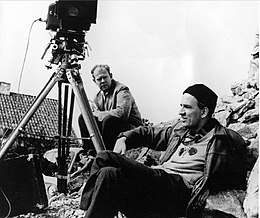
Filmography
Selected work:
- Summer Interlude (1951)
- Summer with Monika (1953)
- Smiles of a Summer Night (1955)
- The Seventh Seal (1957)
- Wild Strawberries (1957)
- The Magician (1958)
- The Virgin Spring (1960)
- Through a Glass Darkly (1961)
- The Pleasure Garden (1961)
- Winter Light (1963)
- The Silence (1963)
- Persona (1966)
- Shame (1968)
- The Passion of Anna (1969)
- The Touch (1971)
- Cries and Whispers (1972)
- Scenes from a Marriage (1973)
- The Magic Flute (1975)
- Face to Face (1976)
- The Serpent's Egg (1977)
- Autumn Sonata (1978)
- Fanny and Alexander (1982)
Style of working
Repertory company
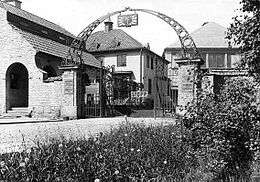
Bergman developed a personal "repertory company" of Swedish actors whom he repeatedly cast in his films, including Max von Sydow, Bibi Andersson, Harriet Andersson, Erland Josephson, Ingrid Thulin, Gunnel Lindblom, and Gunnar Björnstrand, each of whom appeared in at least five Bergman features. Norwegian actress Liv Ullmann, who appeared in nine of Bergman's films and one televisual film (Saraband), was the last to join this group (in the film Persona), and ultimately became the most closely associated with Bergman, both artistically and personally. They had a daughter together, Linn Ullmann (born 1966).
In Bergman's working arrangement with Sven Nykvist, his best-known cinematographer, the two men developed sufficient rapport to allow Bergman not to worry about the composition of a shot until the day before it was filmed. On the morning of the shoot, he would briefly speak to Nykvist about the mood and composition he hoped for, and then leave Nykvist to work, lacking interruption or comment until post-production discussion of the next day's work.
Financing
By Bergman's own account, he never had a problem with funding. He cited two reasons for this: one, that he did not live in the United States, which he viewed as obsessed with box-office earnings; and two, that his films tended to be low-budget affairs. (Cries and Whispers, for instance, was finished for about $450,000, while Scenes from a Marriage, a six-episode television feature, cost only $200,000.)[34]
Technique
Bergman usually wrote his films' screenplays, thinking about them for months or years before starting the actual process of writing, which he viewed as somewhat tedious. His earlier films are carefully constructed and are either based on his plays or written in collaboration with other authors. Bergman stated that in his later works, when on occasion his actors would want to do things differently from his own intention, he would let them, noting that the results were often "disastrous" when he did not do so. As his career progressed, Bergman increasingly let his actors improvise their dialogue. In his later films, he wrote just the ideas informing the scene and allowed his actors to determine the exact dialogue. When viewing daily rushes, Bergman stressed the importance of being critical but unemotive, claiming that he asked himself not if the work was great or terrible, but rather if it was sufficient or needed to be reshot.[34]
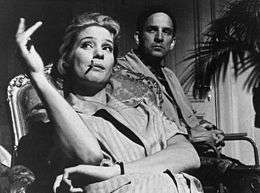
Subjects
Bergman's films usually deal with existential questions of mortality, loneliness, and religious faith. In addition to these cerebral topics, however, sexual desire features in the foreground of most of his films, whether the central event is medieval plague (The Seventh Seal), upper-class family activity in early twentieth century Uppsala (Fanny and Alexander), or contemporary alienation (The Silence). His female characters are usually more in touch with their sexuality than their male equivalents, and unafraid to proclaim it, sometimes with breathtaking overtness (as in Cries and Whispers) as would define the work of "the conjurer," as Bergman called himself in a 1960 TIME cover story.[35] In an interview with Playboy in 1964, he said: "The manifestation of sex is very important, and particularly to me, for above all, I don't want to make merely intellectual films. I want audiences to feel, to sense my films. This to me is much more important than their understanding them." Film, Bergman said, was his demanding mistress.[36] While he was a social democrat as an adult, Bergman stated that "as an artist I'm not politically involved ... I don't make propaganda for either one attitude or the other."[37]
Bergman's views on his career
When asked in the series of interviews later titled "Ingmar Bergman – 3 dokumentärer om film, teater, Fårö och livet" conducted by Marie Nyreröd for Swedish TV and released in 2004, Bergman said that of his works, he held Winter Light,[38] Persona, and Cries and Whispers[39] in the highest regard. There he also states that he managed to push the envelope of film making in the films Persona and Cries and Whispers. Bergman stated on numerous occasions (for example in the interview book Bergman on Bergman) that The Silence meant the end of the era in which religious questions were a major concern of his films. Bergman said that he would get depressed by his own films: "jittery and ready to cry... and miserable."[40] In the same interview he also stated: "If there is one thing I miss about working with films, it is working with Sven" (Nykvist), the third cinematographer with whom he had collaborated.
Theatrical work
Although Bergman was universally famous for his contribution to cinema, he was also an active and productive stage director all his life. During his studies at what was then Stockholm University College, he became active in its student theatre, where he made a name for himself early on. His first work after graduation was as a trainee-director at a Stockholm theatre. At twenty-six years, he became the youngest theatrical manager in Europe at the Helsingborg City Theatre. He stayed at Helsingborg for three years and then became the director at Gothenburg city theatre from 1946 to 1949.
He became director of the Malmö city theatre in 1953, and remained for seven years. Many of his star actors were people with whom he began working on stage. He was the director of the Royal Dramatic Theatre in Stockholm from 1960 to 1966, and manager from 1963 to 1966, where he began a long-time collaboration with choreographer Donya Feuer.
After Bergman left Sweden because of the tax evasion incident, he became director of the Residenz Theatre of Munich, Germany (1977–84). He remained active in theatre throughout the 1990s and made his final production on stage with Henrik Ibsen's The Wild Duck at the Royal Dramatic Theatre in 2002.
Personal life
Marriages and children

Bergman was married five times:
- 25 March 1943 – 1945, to Else Fisher (1 March 1918 – 3 March 2006), choreographer and dancer (divorced). Children:
- Lena Bergman, actress, born 1943.
- 22 July 1945 – 1950, to Ellen Lundström (23 April 1919 – 6 March 2007), choreographer and film director (divorced). Children:
- Eva Bergman, film director, born 1945
- Jan Bergman, film director (1946–2000)
- the twins Mats and Anna Bergman, both actors and film directors, born in 1948.
- 1951 – 1959, to Gun Grut (1916–1971), journalist (divorced). Children:
- Ingmar Bergman Jr., retired airline captain, born 1951.
- 1959 – 1969, to Käbi Laretei (14 July 1922 – 31 October 2014), concert pianist (divorced). Children:
- Daniel Bergman, film director, born 1962.
- 11 November 1971 – 20 May 1995, to Ingrid von Rosen (maiden name Karlebo). Children:
- Maria von Rosen, author, born 1959.
The first four marriages ended in divorce, while the last ended when his wife Ingrid died of stomach cancer in 1995, aged 65. Aside from his marriages, Bergman had romantic relationships with actresses Harriet Andersson (1952–55), Bibi Andersson (1955–59), and Liv Ullmann (1965–70). He was the father of writer Linn Ullmann with Ullmann. In all, Bergman had nine children, one of whom predeceased him. Bergman eventually married all the mothers of his children, with the exception of Liv Ullmann. His daughter with his last wife, Ingrid von Rosen, was born twelve years before their marriage.
Although Bergman described himself as one who had lost his faith in an afterlife, Max Von Sydow stated in an interview that he had had many discussions with him about religion, and indicated that Bergman's belief in the afterlife was restored.[41]
Awards and nominations
In 1971, Bergman received the Irving G. Thalberg Memorial Award at the Academy Awards ceremony. Three of his films (Through a Glass Darkly, The Virgin Spring, and Fanny and Alexander) won the Academy Award for Best Foreign Language Film. He represented all of the Academy Award wins of Sweden so far. He won the Palme D’or award for The Best Intentions, as well as the Best Director award in the Cannes Film Festival; he won the Golden Bear for Wild Strawberries. He won many others and has been nominated for numerous awards.
Academy Awards
| Year | Category | Nominated work | Result |
|---|---|---|---|
| 1959 | Best Original Screenplay | Wild Strawberries | Nominated |
| 1960 | Best Foreign Language Film | The Virgin Spring | Won |
| 1961 | Best Foreign Language Film | Through a Glass Darkly | Won |
| 1962 | Best Original Screenplay | Nominated | |
| 1973 | Best Picture | Cries and Whispers | Nominated |
| Best Director | Nominated | ||
| Best Original Screenplay | Nominated | ||
| 1976 | Best Director | Face to Face | Nominated |
| 1978 | Best Original Screenplay | Autumn Sonata | Nominated |
| 1983 | Best Foreign Language Film | Fanny and Alexander | Won |
| Best Director | Nominated | ||
| Best Original Screenplay | Nominated | ||
Legacy
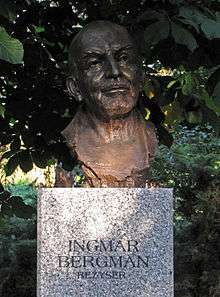
Bergman's work was a point of reference and inspiration to director Woody Allen. His films are mentioned and praised on Annie Hall and other of his films. Allen also admired Bergman's longtime director of photography Sven Nykvist and invited him to be his DP on Crimes and Misdemeanors.[42]
After Bergman died, a large archive of notes was donated to the Swedish Film Institute. Among the notes are several unpublished and unfinished scripts both for stage and films, and many more ideas for works in different stages of development. A never performed play has the title Kärlek utan älskare ("Love without lovers"), and has the note "Complete disaster!" written on the envelope; the play is about a director who disappears and an editor who tries to complete a work he has left unfinished. Other canceled projects include the script for a pornographic film which Bergman abandoned since he did not think it was alive enough, a play about a cannibal, some loose scenes set inside a womb, a film about the life of Jesus, a film about The Merry Widow, and a play with the title Från sperm till spöke ("From sperm to spook").[43] The Swedish director Marcus Lindeen went through the material, and inspired by Kärlek utan älskare he took samples from many of the works and turned them into a play, titled Arkivet för orealiserbara drömmar och visioner ("The archive for unrealisable dreams and visions"). Lindeen's play premiered on 28 May 2012 at the Stockholm City Theatre.[43]
Terrence Rafferty of The New York Times wrote that throughout the 1960s, when Bergman "was considered pretty much the last word in cinematic profundity, his every tic was scrupulously pored over, analyzed, elaborated in ingenious arguments about identity, the nature of film, the fate of the artist in the modern world and so on."[44]
Writer and director, Richard Ayoade, counts Bergman as one of his inspirations. In 2017, the British Film Institute (BFI) hosted an Ingmar Bergman season and Ayoade said in a Guardian interview that he saw everything in it, "which was one of the best two months ever."[45] The BFI's programme included a discussion with Ayoade on Bergman's 1966 film, Persona, before a screening.[46]
Exhibitions
| Year | Exhibition Name | Work |
|---|---|---|
| 2012 | The Image Maker | Ingmar Bergman |
| 2012 | The Man Who Asked Hard Questions | Ingmar Bergman |
See also
- Cinema of Sweden
- List of film collaborations
Notes
- Swedish pronunciation: [ˈɪ̌ŋːmar ˈbæ̌rjman] (

References
- Rothstein, Mervyn (30 July 2007). "Ingmar Bergman, Master Director, Dies at 89". The New York Times. ISSN 0362-4331. Retrieved 31 July 2007.
Ingmar Bergman, the 'poet with the camera' who is considered one of the greatest directors in motion picture history, died today on the small island of Faro where he lived on the Baltic coast of Sweden, Astrid Soderbergh Widding, president of The Ingmar Bergman Foundation, said. Bergman was 89.
- Tuohy, Andy (3 September 2015). A-Z Great Film Directors. Octopus. ISBN 9781844038558.
- Gallagher, John (1 January 1989). Film Directors on Directing. ABC-CLIO. ISBN 9780275932725.
- French, Philip (5 August 2007). "Twin visionaries of a darker art". The Observer. Retrieved 15 May 2017.
- Mercury (9 May 2010). "Philosophy of Science Portal: Film maker on film maker...Martin Scorsese on Ingmar Bergman". Philosophy of Science Portal. Retrieved 16 March 2019.
- Steene 2005, p. 23.
- Gado 1986, p. 374.
- In a book published in 2011, Bergman's niece Veronica Ralston suggested that the director was not identical to the child born to Erik and Karin Bergman in July 1918. Ralston's claim was that this child would have died and been substituted for another child allegedly born to Erik Bergman in an extramarital relationship. (See Who was the mother of Ingmar Bergman? Dagens Nyheter, 26 May 2011. Retrieved 28 May 2011.) The DNA evidence was weakened after the laboratory consulted by Ralston clarified that it had only been possible to extract DNA from one out of two stamps submitted for testing, and the child supposedly substituted for the newborn child of Karin Bergman was later identified as having emigrated to the US in 1923 with his adopted parents and lived there until his death in 1982 (Clas Barkman, "Nya turer i mysteriet kring Bergman", Dagens Nyheter, 4 June 2011. Retrieved 8 June 2011).
- Kalin, Jesse (2003). The Films of Ingmar Bergman. p. 193.
- Rothstein, Mervyn (31 July 2007). "Ingmar Bergman, Master Filmmaker, Dies at 89". The New York Times.
- For an extended discussion of the profound influence that August Strindberg's work played in Bergman's life and career, see: Ottiliana Rolandsson, Pure Artistry: Ingmar Bergman, the Face as Portal and the Performance of the Soul, Ph.D. dissertation, University of California, Santa Barbara, 2010, especially chapter 3, "Bergman, Strindberg and the Territories of Imagination".
- Steene 2005, p. 33.
- Gado 1986, p. 59.
- Macnab, Geoffrey (2009). Ingmar Bergman: The Life and Films of the Last Great European Director. I.B. Tauris. ISBN 978-0857713575.
- Vermilye, Jerry (2001). Ingmar Bergman: His Life and Films. p. 6.; see also Bergman's autobiography, Laterna Magica.
- Ingmar Bergman, The Magic Lantern (transl. from Swedish: Laterna Magica), Chicago: University of Chicago Press, 2007; ISBN 978-0-226-04382-1.
- "Bergman admits Nazi past". BBC News. 7 September 1999.
- Peter Ohlin. (2009.) "Bergman's Nazi Past", Scandinavian Studies, 81(4):437-74.
- Vermilye, Jerry (2001). Ingmar Bergman: His Life and Films. p. 6.
- Ingmar Bergman, Images : my life in film (translated from the Swedish by Marianne Ruuth), London: Bloomsbury, 1994. ISBN 0-7475-1670-7.
- Bergman, Ingmar. in the Aftonbladet (9 October 1944) (translated from Swedish)
- Fristoe, Roger. "Torment (1944)". Turner Classic Movies, Inc. Retrieved 28 March 2017.
- Stated in Marie Nyreröd's interview series (the first part named Bergman och filmen) aired on Sveriges Television Easter 2004.
- In contrast, in 1964 Bergman had the three scripts published in a single volume: "These three films deal with reduction. Through a Glass Darkly – conquered certainty. Winter Light – penetrated certainty. The Silence – God's silence — the negative imprint. Therefore, they constitute a trilogy." The Criterion Collection groups the films as a trilogy in a boxed set. In the 1963 documentary Ingmar Bergman Makes a Movie, about the making of Winter Light, supports the idea that Bergman did not plan a trilogy. In the interview with Bergman about writing the script of Winter Light, and the interviews made during the shooting of it, he hardly mentions Through a Glass Darkly. Instead, he discusses the themes of Winter Light, in particular the religious issues, in relation to The Virgin Spring.
- Theall, Donald F. (1995). Beyond the Word: reconstructing sense in the Joyce era of technology, culture, and communication. p. 35. ISBN 9780802006301.
- "The 46th Academy Awards (1974) Nominees and Winners". Academy of Motion Picture Arts and Sciences. Archived from the original on 15 March 2015. Retrieved 31 December 2011.
- Åtal mot Bergman läggs ned [Charges against Bergman dropped]. Rapport (in Swedish). Sveriges Television. 23 March 1976. Archived from the original (News report) on 21 November 2011.
- Generaldirektör om Bergmans flykt [The Director General about Bergman's escape]. Rapport (in Swedish). Sveriges Television. 22 April 1976. Archived from the original (News report) on 4 September 2011.
- Harry Schein om Bergmans flykt [Harry Schein about Bergman's escape]. Rapport (in Swedish). Sveriges Television. 22 April 1976. Archived from the original (News report) on 20 November 2011.
- Ephraim Katz, The Film Encyclopedia, New York: HarperCollins, 5th ed., 1998.
- Ingmar Bergman: Samtal på Fårö [Ingmar Bergman: Talks on Fårö] (in Swedish), Sveriges Radio, 28 March 2005
- "Bergman was buried in a quiet ceremony". BBC News. London. 18 August 2007. Retrieved 5 January 2010.
- "Film Great Ingmar Bergman Dies at 89". 30 July 2007. Archived from the original on 26 September 2007. Retrieved 30 July 2007.
- American Film Institute seminar, 1975, on The Criterion Collection's 2006 DVD of The Virgin Spring.
- "THE SCREEN: I Am A Conjurer". Time. 14 March 1960. Retrieved 16 November 2009.
- Koskinen, Maaret (1 April 2010). Ingmar Bergman's The Silence: Pictures in the Typewriter, Writings on the Screen. University of Washington Press. ISBN 9780295801957.
- Bergman on Bergman: Interviews with Ingmar Bergman. By Stig Björkman, Torsten Manns, and Jonas Sima; translated by Paul Britten Austin. Simon & Schuster, New York. p. 176-178. Swedish edition copyright 1970; English translation 1973.
- "Winter Light". 2005.
- Steene 2005.
- "Bergman 'depressed' by own films". BBC News. London. 10 April 2004. Retrieved 2 October 2019.
- Max von Sydow on Ingmar Bergman on YouTube
- "Bergman's Influence on Woody Allen". 5 June 2014.
- Jacobsson, Cecilia (28 May 2012). "Ingmar Bergmans ratade texter blev ny pjäs" [Ingmar Bergman's rejected texts became new play]. Dagens Nyheter (in Swedish). Retrieved 2 October 2019.
- Rafferty, Terrence (8 February 2004). "FILM; On the Essential Strangeness of Bergman". The New York Times. p. 13.
- Petridis, Alexis (15 January 2011). "Richard Ayoade: Meet Mr Modest". The Guardian. ISSN 0261-3077. Retrieved 28 November 2019.
- "BFI announces further details of Ingmar Bergman centenary celebrations" (PDF). BFI. 28 November 2017. Retrieved 28 November 2019.
Bibliography
- Bergman on Bergman: Interviews with Ingmar Bergman. By Stig Björkman, Torsten Manns, and Jonas Sima; translated by Paul Britten Austin. Simon & Schuster, New York. Swedish edition copyright 1970; English translation 1973.
- Filmmakers on filmmaking: the American Film Institute seminars on motion pictures and television (edited by Joseph McBride). Boston, Houghton Mifflin Co., 1983.
- Images: my life in film, Ingmar Bergman. Translated by Marianne Ruuth. New York, Arcade Pub., 1994, ISBN 1-55970-186-2
- Steene, Birgitta (1 January 2005). Ingmar Bergman: A Reference Guide. Amsterdam University Press. ISBN 9789053564066.
- The Magic Lantern, Ingmar Bergman. Translated by Joan Tate New York, Viking Press, 1988, ISBN 0-670-81911-5
- The Demons of Modernity: Ingmar Bergman and European Cinema, John Orr, Berghahn Books, 2014.
- Gado, Frank (1986). The Passion of Ingmar Bergman. Duke University Press. ISBN 0822305860.
External links
![]()
![]()
- Ingmar Bergman at the Encyclopædia Britannica
- Ingmar Bergman on IMDb
- Ingmar Bergman at the Swedish Film Database

- Ingmar Bergman at the TCM Movie Database

- Ingmar Bergman, film on The Guardian
- Ingmar Bergman on the British Film Institute
- Ingmar Bergman Face to Face
- The Ingmar Bergman Foundation
- Ingmar Bergman all posters
- Bergmanorama: The magic works of Ingmar Bergman
- The Guardian/NFT interview with Liv Ullmann by Shane Danielson, 23 January 2001
- Bergman Week
- Regilexikon
- DVD Beaver's Director's Chair on Bergman, with links to DVD and Blu-ray comparisons of his major films
- Bibliographies